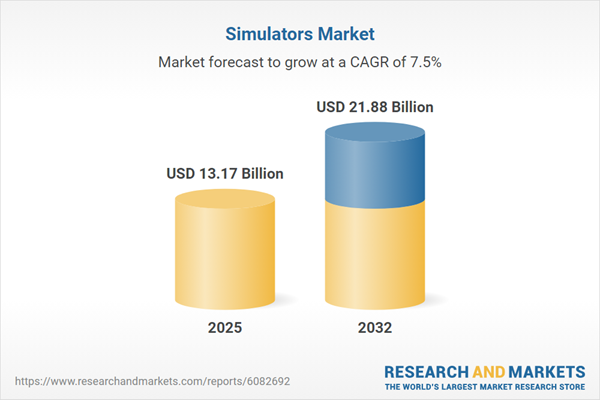Speak directly to the analyst to clarify any post sales queries you may have.
The simulators market is rapidly transforming conventional training and operational paradigms, empowering organizations with technologically advanced and adaptable simulation solutions that enhance performance, reduce risk, and address dynamic business requirements.
Market Snapshot: Simulators Market Size and Momentum
The simulators market is experiencing significant expansion, increasing from USD 12.30 billion in 2024 to USD 13.17 billion in 2025 and projected to reach USD 21.88 billion by 2032, reflecting a compound annual growth rate (CAGR) of 7.46%. This momentum is driven by robust uptake across multiple sectors, including automotive, aerospace, defense, healthcare, and education. Market growth is fueled by the demand for scalable, high-fidelity simulation platforms that support sophisticated computational systems, immersive environments, and advanced user interfaces. Enhanced by advancements in artificial intelligence, virtual reality, and integrated hardware, simulation technologies are setting new standards for workforce training, system design, and operational excellence.
Scope & Segmentation: Comprehensive Coverage of the Simulators Market
This report provides granular segmentation and analysis, supporting precise planning and targeted deployment for business leaders seeking optimal simulation solutions:
- Product Types: Computer simulators, commercial driving simulators, defense driving simulators, racing driving simulators, fixed-base simulators, flight training devices, full flight simulators, patient simulators, procedure simulators, surgical medical simulators.
- Technologies: Artificial intelligence (AI) integration, augmented reality (AR), mixed reality (MR), motion simulation technology, virtual reality (VR).
- Applications: Analysis and planning, gaming and entertainment, product design and prototyping, research and development, training.
- End-use Industries: Aerospace and defense, automotive, education and academia, energy, gaming and entertainment, healthcare, marine, railways.
- Regions Covered: Americas (including North America and Latin America), Europe Middle East & Africa (with dedicated national subsegments), Asia-Pacific (covering China, India, Japan, and other key markets).
- Key Companies Profiled: CAE Inc., L3Harris Technologies, Inc., Lockheed Martin Corporation, The Boeing Company, Thales Group, Northrop Grumman Corporation, Raytheon Technologies Corporation, General Dynamics Corporation, BAE Systems plc, Saab AB, Cre8tive Rooms, Indra Sistemas, Kongsberg Gruppen ASA, Pulseworks, Unitest Marine Simulators, FlightSafety International, Wärtsilä Corporation, TRU Simulation + Training, Elbit Systems, RUAG Holding AG, OKTAL-SE, VSTEP B.V., QinetiQ Group, Navantia SA, Bohemia Interactive Simulations, Teledyne Technologies Incorporated.
Strategic segmentation allows organizations to address diverse operational environments and regulatory needs, enabling tailored deployment and streamlining integration for maximum impact.
Key Takeaways for Strategic Decision-Making
- Modern simulation platforms integrate advanced motion, tactile, and visual technologies to deliver comprehensive, practical learning and operational assessment across both civil and defense domains.
- Emerging capabilities like artificial intelligence and mixed reality enable adaptive, user-focused training, supporting faster skill development and improved retention.
- Unified hardware and software solutions provide scalable and flexible simulation frameworks, customizable for different operational contexts and evolving business requirements.
- Regional leaders in North America, Europe, and Asia-Pacific drive innovation, supported by collaborative initiatives and strong alliances between public and private stakeholders.
- Strategic partnerships among technology specialists, academic institutions, and end-users promote accelerated development and frictionless market integration, strengthening competitive positioning.
Tariff Impact: Navigating Complex Supply Chains
Recent US tariffs have prompted simulator providers to re-evaluate sourcing and supply chain strategies for simulation hardware and critical components. Many are expanding their supplier networks and focusing on localized assembly, which helps mitigate tariff exposure and shortens go-to-market timelines. By leveraging modular product designs, companies can quickly manage fluctuations in input costs, maintain production agility, and ensure consistent delivery. In sectors like aerospace and defense, greater emphasis on domestic sourcing supports compliance, enhances agility, and aligns with regulatory requirements amid evolving trade policies.
Methodology & Data Sources
This analysis synthesizes insights from primary interviews with industry technology leaders, business decision-makers, and end users, paired with secondary research from technical literature, industry regulations, and case studies. The combination of quantitative and qualitative methods ensures the findings are reliable and relevant for strategic planning.
Why This Report Matters
- Delivers actionable, segment-level intelligence to support simulation technology adoption, resource optimization, and informed risk management.
- Facilitates benchmarking against industry leaders and clarifies how changing policy and supply chain structures may affect strategy.
- Enables senior decision-makers to anticipate industry trends, align investments, and retain strong competitive standing as the simulators market evolves.
Conclusion
Simulation technologies are advancing critical capabilities in training, research, and operational innovation. Insights from this report help organizations strengthen performance, support strategic alignment, and respond to rapidly shifting market dynamics.
Table of Contents
3. Executive Summary
4. Market Overview
7. Cumulative Impact of Artificial Intelligence 2025
Companies Mentioned
The companies profiled in this Simulators market report include:- CAE Inc.
- L3Harris Technologies, Inc.
- Lockheed Martin Corporation
- The Boeing Company
- Thales Group
- Northrop Grumman Corporation
- Raytheon Technologies Corporation
- General Dynamics Corporation
- BAE Systems PLC
- Saab AB
- BAE Systems PLC
- Cre8tive Rooms
- Indra Sistemas, S.A.
- Kongsberg Gruppen ASA
- Pulseworks, LLC
- Raytheon Technologies Corporation
- Unitest Marine Simulators Ltd.
- FlightSafety International Inc.
- Wärtsilä Corporation
- TRU Simulation + Training
- Elbit Systems Ltd.
- RUAG Holding AG
- OKTAL-SE
- VSTEP B.V.
- QinetiQ Group
- Navantia SA
- Bohemia Interactive Simulations
- Teledyne Technologies Incorporated
Table Information
| Report Attribute | Details |
|---|---|
| No. of Pages | 196 |
| Published | November 2025 |
| Forecast Period | 2025 - 2032 |
| Estimated Market Value ( USD | $ 13.17 Billion |
| Forecasted Market Value ( USD | $ 21.88 Billion |
| Compound Annual Growth Rate | 7.4% |
| Regions Covered | Global |
| No. of Companies Mentioned | 29 |









